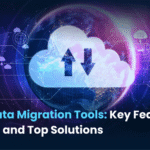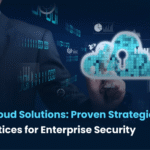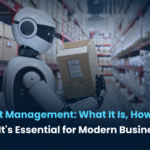Data Governance in the Era of Generative AI

As generative AI structures flow from the lab to the boardroom, data governance has taken center stage. It’s now not pretty much compliance checklists or metadata catalogs. In nowadays’s panorama, agency statistics governance has emerged as a vital pillar of accountable AI development, protecting privacy, ensuring data exceptional, and assisting agencies navigate unexpectedly converting regulatory and moral terrain.
Generative AI has shifted the governance game. It’s not simply that models are trained on huge datasets, a lot of which are unlabeled, semi-structured, or publicly scraped, but also that they generate new records. That creates an increasing frontier of content material that needs to be ruled just as tightly as supply records.
But how does an organisation put into effect powerful data governance in this new technology? And what new responsibilities, practices, and technologies are emerging?
Let’s see this all below!
How to Implement Data Governance for Generative AI
From Structured Rules to Adaptive Frameworks
Traditionally, fact governance is based on data, transaction statistics, relational databases, and spreadsheets. These have been easy to audit and steady. But Generative AI information is vastly extra complicated. Text, pictures, embeddings, and information vectors frequently fall out of doors preferred governance frameworks.
To adapt, groups are taking a layered method:
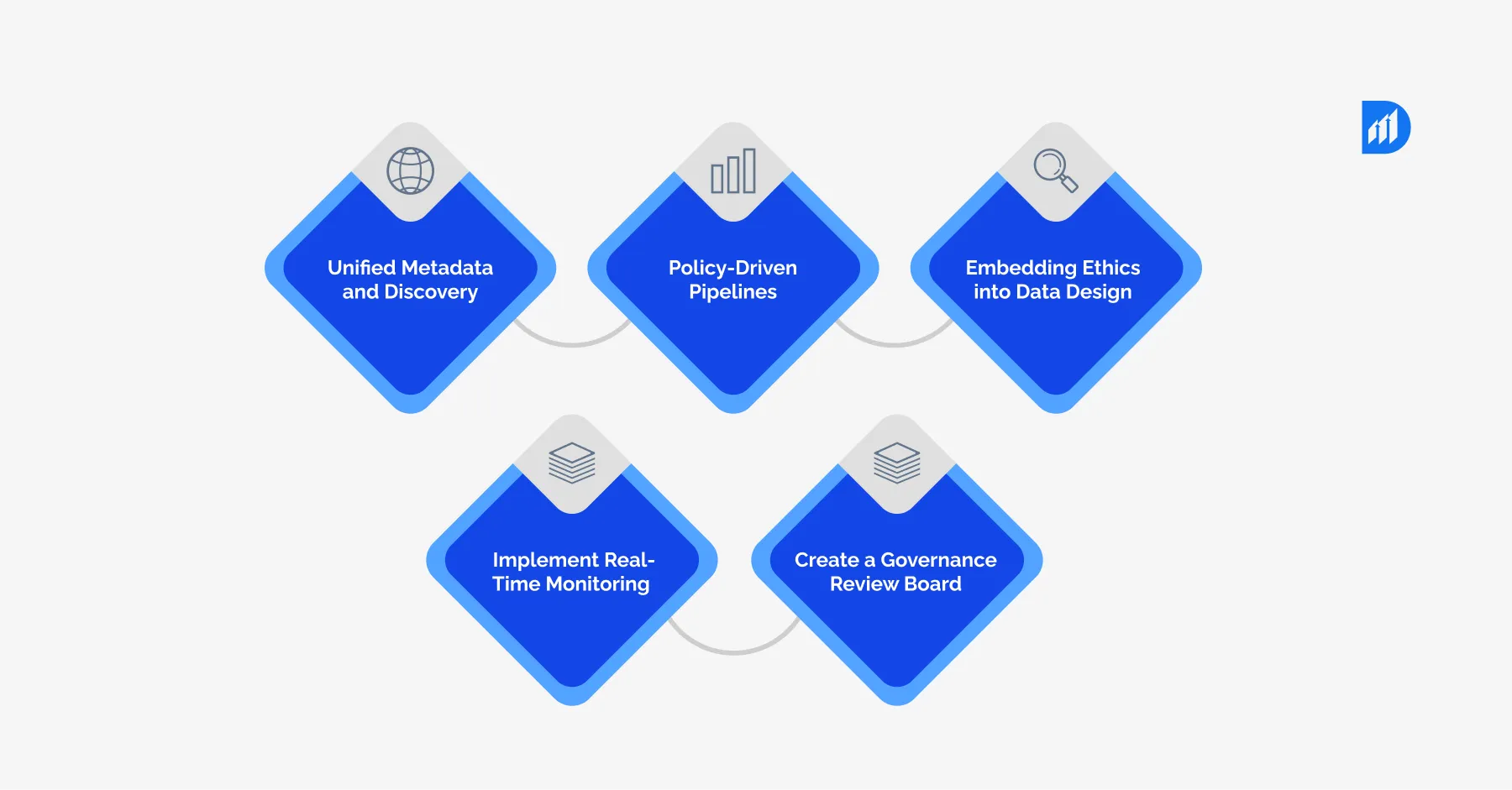
1. Unified Metadata and Discovery
Enterprise fact structures like Microsoft Purview, Collibra, and Informatica are now integrating AI-assisted information discovery. For example, one Fortune 500 insurance employer used Azure Purview to catalog over 4 million unstructured files. By leveraging NLP-primarily based scanning, they mechanically tagged ninety 2% of documents with commercial enterprise-context labels, reducing guide effort by way of over 60%.
This discovery layer forms the muse of contemporary governance; if the business does not understand what statistics it owns, everything downstream is at risk.
2. Policy-Driven Pipelines
Instead of writing rules once and hoping groups comply with them, businesses are embedding governance immediately into information engineering pipelines.
In exercise, an international e-commerce platform now enforces governance regulations that routinely mask PII fields at ingestion using Apache Spark. If a dataset incorporates names or emails, it’s hashed, logged, and flagged for assessment, all without human intervention.
This type of AI-pushed records compliance guarantees that governance becomes proactive, no longer reactive.
3. Embedding Ethics into Data Design
Generative AI raises critical moral questions: Was this content made from copyrighted information? Does the version perpetuate bias? Was consent captured?
To deal with this, one financial firm developed a “moral dataset constitution” outlining ideal assets for GenAI training. Content ought to be:
- Freely certified or proprietary,
- Fully attributable,
- Free of discriminatory content material,
- Collected with consent (whilst human statistics is concerned).
They constructed these rules into their information ingestion and curation workflows, governed by layout.
4. Implement Real-Time Monitoring
Now, we focus not only on what the model learned during training but also on what it generates. We installed GenAI content video display units that flag volatile outputs, which include hallucinations, toxic language, and privacy leaks.
5. Create a Governance Review Board
We assembled a pass-functional crew, inclusive of prison, data science, compliance, and engineering, to study information intake and version outputs. No new dataset or version goes live without passing this gate.
Data Governance Challenges with AI‑Generated Content
Managing the Output, Not Just the Input
One of the most misunderstood factors of information governance in the era of generative AI is that governance also needs to follow AI-generated content.
This poses three precise demanding situations:
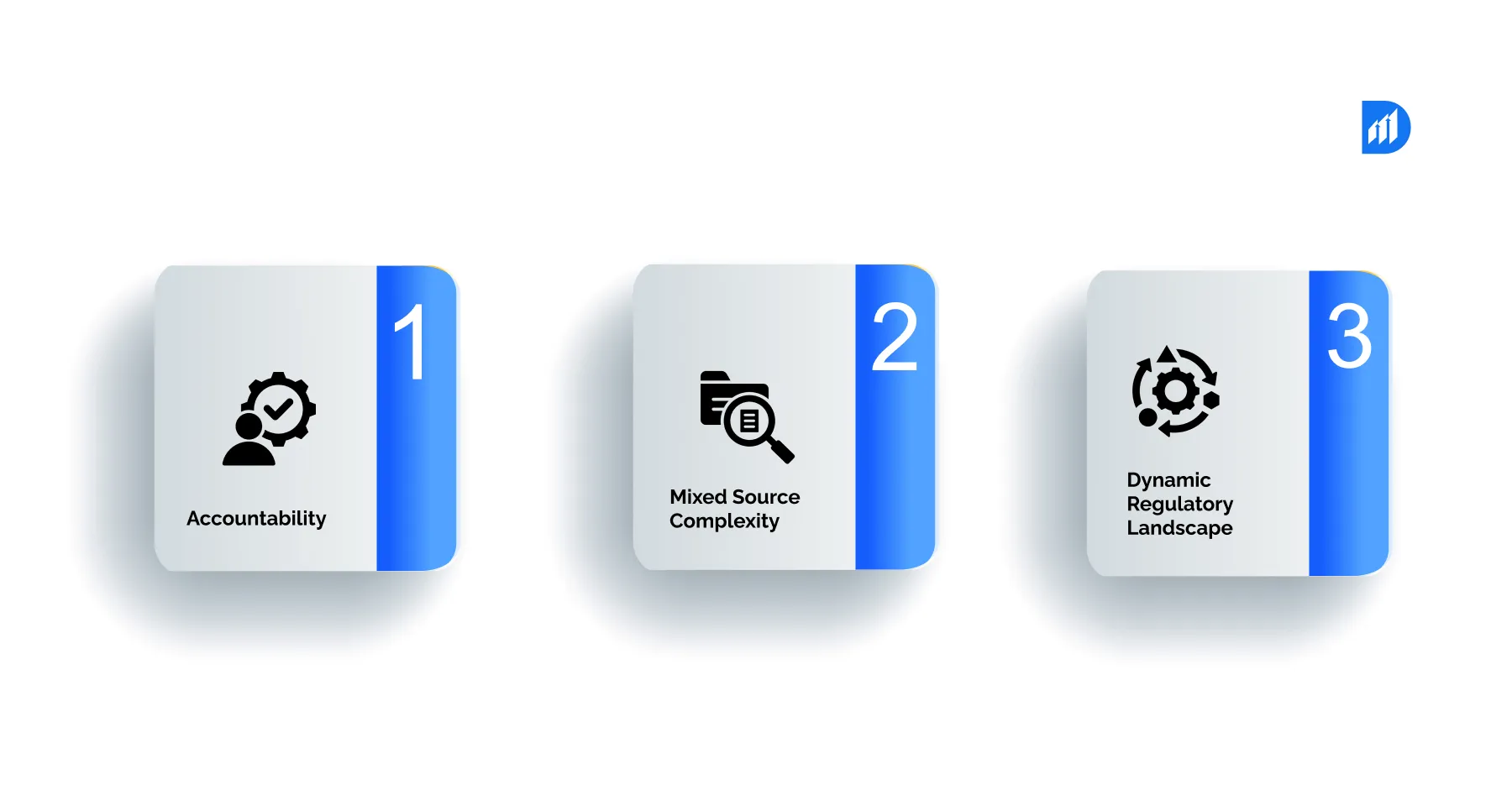
1. Accountability
Generative fashions like GPT or Claude can “hallucinate”, fabricating info that looks actual but isn’t. For instance, a retail chatbot would possibly, with a bit of luck, inform a customer their refund has been accepted, even though no such coverage exists.
To mitigate this, businesses are enforcing:
- Confidence scoring: flagging low-fact outputs,
- Human-in-the-loop assessment: in particular for consumer-dealing with content material,
- Traceability: logging the source spark off, context, and dataset lineage.
At a pinnacle-10 international bank, these practices decreased miscommunication incidents from 3.2% to 0.4% over a six-month pilot.
2. Mixed Source Complexity
Unlike conventional analytics, generative structures frequently mix proprietary and public datasets. One production company is training a GenAI version to summarize product manuals needed to reconcile content from internal files, customer support logs, and scraped seller documentation.
The hassle? Public statistics resources raised copyright and privacy red flags.
This induced a full danger control evaluation and the implementation of a source filtering process that blocks any unverified third-party data from entering the training pipeline.
3. Dynamic Regulatory Landscape
Regulations, just like the EU AI Act, the U.S. AI Bill of Rights, and Canada’s AIDA, are redefining regulatory compliance for AI. These guidelines include precise obligations round education statistics, auditability, transparency, and bias mitigation.
Organizations at the moment are building governance councils that encompass not simply IT and criminal, but additionally product teams and data scientists, making sure top-down buy-in.
Best Practices for AI‑Driven Data Compliance
Implementing effective information governance for generative AI doesn’t require reinventing the wheel, but it does call for a shift in tradition, tooling, and method approach.
Here are 5 exceptional practices that leading enterprises are applying these days:
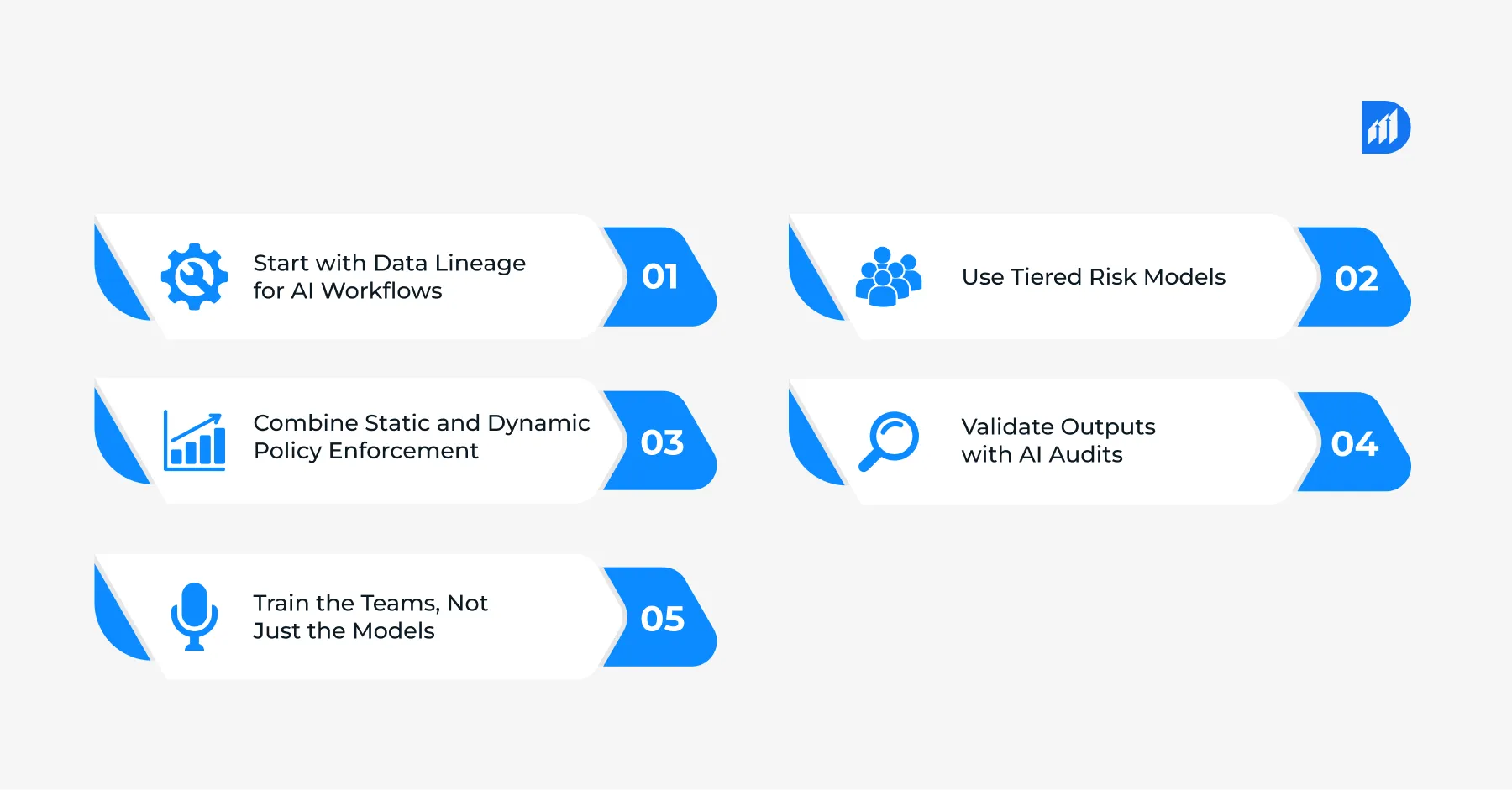
1. Start with Data Lineage for AI Workflows
Data lineage equipment needs to expand past SQL pipelines to consist of vector databases, embedding models, and spark off histories. For instance, AWS Glue and OpenMetadata permit corporations to track precisely how an internal policy document will become a part of a chatbot’s RAG reaction flow.
This lineage ensures that statistical protection and privacy are not lost in translation.
2. Use Tiered Risk Models
Not all AI use instances require an equal level of oversight. Classify use cases primarily based on:
- Data sensitivity,
- Model autonomy,
- Business effect.
A healthcare chatbot getting access to clinical facts needs to have stricter controls than an internal code summarization tool.
Tiering reduces overhead while preserving crucial workflows securely.
3. Combine Static and Dynamic Policy Enforcement
Many governance tools now support runtime tests, like stopping a dataset categorised as “sensitive” from being used in public API deployments. Integrate with CI/CD to dampen volatile version pushes.
Case in point: a biotech agency’s compliance pipeline flagged a model replace that covered patient notes. The deployment turned into a halt in staging, heading off a capacity HIPAA violation.
4. Validate Outputs with AI Audits
GenAI audits must consist of:
- Prompt assessment,
- Output verification,
- Bias detection (demographic skew),
- Fairness checking out.
Companies like OneTrust and Credo AI are offering governance platforms targeted in particular on AI audits.
5. Train the Teams, Not Just the Models
Upskilling business users, information scientists, and analysts on ethical information management is key.
Monthly governance briefings, embedded documentation, and simulation-based training assist groups in spotting issues early, before they emerge as compliance disasters.
The Role of Enterprise Data Governance
This all ties into the wider umbrella of organization records governance. At an organizational level, it’s approximately:
- Defining who owns what data
- Creating regulations around the records lifecycle (introduction to deletion)
- Aligning AI statistics practices with business risk tolerance
We aligned our GenAI governance projects with our current master information governance programs. That is supposed to integrate our metadata catalog with our GenAI tools and make sure our records stewards have visibility into AI usage.
What surprised us? A lot of our pre-existing governance infrastructure was extraordinarily reusable. Once we added AI-unique controls, we discovered that we were not constructing from scratch, but adapting.
Enterprise Data Governance: Real-World Application
At a business enterprise stage, deploying sturdy governance for generative AI entails integrating people, techniques, and systems.
A case study from a multinational logistics corporation illustrates this nicely:
- Data Inventory: Using Ataccama ONE, they scanned 27TB of information property across AWS S3, Snowflake, and SharePoint.
- Classification: three hundred+ information types had been automobile-tagged, including PII, financial records, and operational metrics.
- Governance Modeling: Developed policy bushes for 12 AI use instances, along with pricing fashions, bill type, and patron chatbot content.
Results:
- Reduced time-to-compliance tests by using 48%,
- Achieved ISO/IEC 27001 compliance six months ahead of schedule,
- Logged 99.7% lineage coverage for GenAI inputs and outputs.
This wasn’t just a compliance win. It empowered quicker product new release, in particular in areas where GenAI has been adopted unexpectedly.
Master Data Governance in a Gen AI World
The upward push of generative AI doesn’t reduce the significance of master data; it will increase it. When models are high-quality-tuned on inconsistent, reproduction, or previous statistics, performance suffers.
One international store found that 21% of its product catalog had inconsistent naming conventions. This led to GenAI content generation that referred to merchandise with the wrong SKUs or miscategorized capabilities.
By investing in grasp information governance, standardizing naming, consolidating source-of-fact records, and enhancing deduplication, product accuracy in AI-generated descriptions jumped with the aid of 33%.
Master data now serves as the schooling baseline for generative structures. If it’s incorrect, the version is incorrect.
Ethical Data Management: Beyond the Basics
Ethics in generative AI isn’t just about averting damage. It’s about building systems that might be inclusive, obvious, and honest.
A survey via PwC found that eighty 5% of customers said they’d forego doing business with a corporation in the event that they misplaced accept as true with in how their data is used by AI. That’s a brand threat that few organizations can have enough money.
Ethical governance now consists of:
- Bias detection pipelines: flagging whilst models skew closer to particular demographics,
- Explainability tools: surfacing which datasets stimulated an output,
- Usage disclosures: informing customers when content material is AI-generated.
In a few areas, failure to put into effect such practices may want to bring about prison consequences under upcoming legislation.
Why Ethical Data Management Matters More Than Ever
Let’s get real: governance isn’t just about guidelines. It’s about duty. The potential of AI to scale mistakes is terrifying. Which is why ethical statistics control isn’t some experience-top tagline; it’s a survival method.
Think of it this way: in case your AI gadget inadvertently generates discriminatory or deceptive content, and that goes live in a purchaser-going through product, you’re now not just risking fines. You’re risking trust. And in tech, accept as true with is tough-earned and without difficulty misplaced.
So we created an internal ethical assessment technique. Any time we launch a new version or use case, it gets reviewed now not only for performance, however for social effect. That consists of asking:
Could this version be misused?
Are any agencies negatively impacted by its predictions or outputs?
Have we accounted for explainability?
It’s a long way higher than hoping things go right.
Lessons Learned from Our Own Implementation
Implementing GenAI at scale is exhilarating and hard in identical measure. Here are a few of our internal takeaways:
- Don’t expect your data to be clean. It hardly ever is. You’ll want a committed information information-pleasant assurance process.
- Regulatory compliance is a ground, not a ceiling. Aim higher.
- Governance oughtn’t to kill pace. When embedded properly, it definitely facilitates.
- You want purchase-in throughout the org. Governance can not be enforced from the basement.
- Your first version will likely get it wrong. And that’s ok. Just make sure the device catches it.
The ROI of Responsible Data Governance
While the value of imposing strong statistics governance for GenAI may also appear excessive, the return is even greater.
According to IDC:
Organizations with mature information governance are 1.7x more likely to launch a hit AI initiative,
They gain 2.3x faster time-to-insight,
And record 42% fewer data safety incidents.
In effect, governance doesn’t slow down innovation; it fuels it.
When teams trust their information, they pass faster. The outputs are explainable, and clients buy in. When audits are seamless, compliance will become a feature, no longer a burden..
Final Thoughts: Reimagining Data Governance in a GenAI World
We’re within the early innings of the generative AI revolution, and information governance is not just a returned-office difficulty. It’s the front and middle. The models we build are as right as the facts we feed them and the way we govern that information.
So, in case you’re building GenAI into your products, or maybe experimenting with internal use instances, don’t wait to put governance into effect. Don’t deal with it as a blocker. Treat it as an enabler of accountable, scalable, and moral innovation.
Because at the quit of the day, it’s no longer pretty much what AI can do. It’s about what it should do, and that answer depends completely on how well we govern the facts that power it.
Contact us to know more at www.durapid.com
FAQs
What are the principle demanding situations in data governance for generative AI?
The biggest challenges include monitoring information lineage, dealing with unstructured statistics, mitigating bias, and ensuring compliance with regulations like GDPR and HIPAA. Governance frameworks must be dynamic and AI-conscious.
How can enterprises build moral GenAI systems?
Embed ethical reviews into your AI improvement lifecycle. Train teams on bias, set up feedback loops, ensure transparency, and encompass numerous perspectives at some point of the process.
Is traditional information governance nonetheless relevant with AI?
Yes, and more than ever. Traditional frameworks like grasp records governance provide a robust basis, but they ought to be extended to address the specific dangers and unpredictability of generative models.


